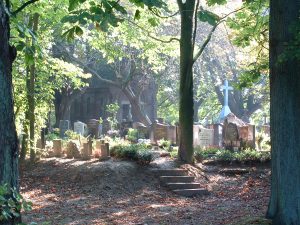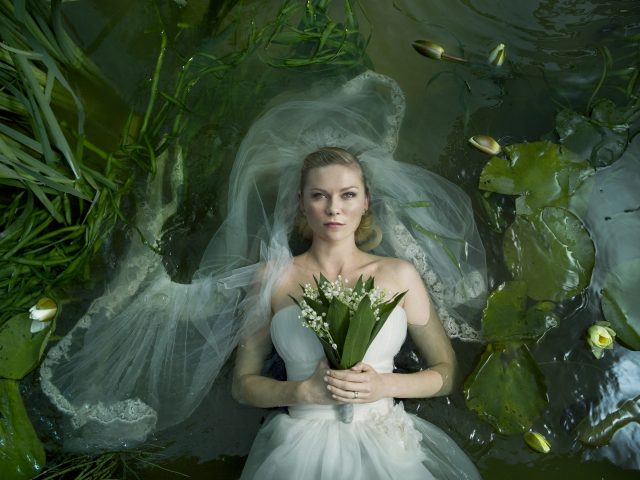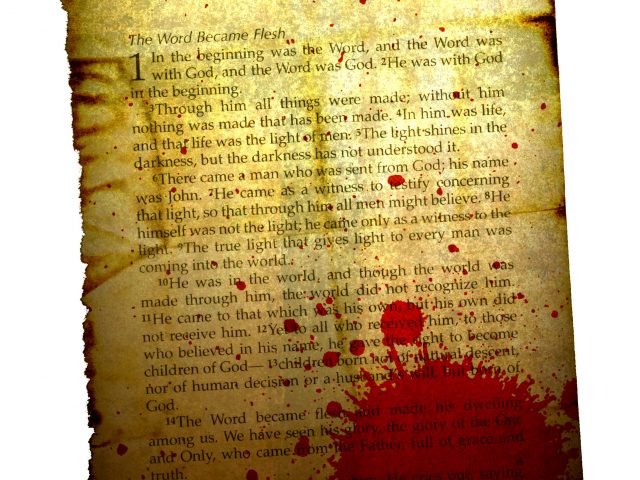Russell Moore makes an interesting observation in Touchstone (September 2008; p. 16-18). He notes that though in the past churches used to have graveyards associated with them, they seldom do anymore. The old arrangement required believers to be reminded of their mortality as they gathered for worship. Today, he notes, churches tend to be surrounded by asphalt. Rather than being reminded of their mortality, 21st century worshippers gather in a setting that is designed to suggest youth, vitality, and in mega-churches, the bustling activity common to a shopping mall.
I’ve never been part of a church that had a graveyard. On a visit to London, however, I attended St Helen’s Bishopsgate, a vibrant, evangelical Anglican church in the heart of the financial district. There was no graveyard, but the dead were all around us. In the walls of the sanctuary (the building dates back to the 13th century) were crypts, each marked with the name of the Christian buried therein. We worshipped in the presence of the dead. I remember thinking I had seldom experienced a better demonstration of the unity of the Church than that morning.
There are lots of reasons—complex sociological, economic, political, even theological reasons—that churches today do not have graveyards associated with them, as Moore recognizes. Still Moore asks, is it possible we’ve lost something in the process? He suggests we might have lost the sense that all will perish apart from the gospel. “Maybe a cemetery,” Moore says, “would serve as a icon that all our Babels will collapse.” Perhaps the perverse seduction of pride and the tendency to allow the important to be pushed aside by the merely urgent would be lessened with a weekly reminder that we too will soon die.
“Find an old graveyard,” Moore suggests, “and walk through it. Walk about and see the headstones weathered and ground down by the elements. Contemplate the fact that beneath your feet are men and women who once had youthful skin and quick steps and hectic calendars.” Perhaps walking past a graveyard would remind us that worship, though properly joyous, is also a serious matter touching on the deepest mysteries of life—and death. “Maybe,” Moore says, “we’d be able to speak more honestly to a people scared to death of death if we offered them and ourselves a visible sign that we, too, know what death is, and that we hate it, too.”
I find these reflections interesting. Interesting for what they tell us about how our world has changed. Interesting for what the changes reveal about life, and about us. And interesting for reminding us that nothing in life is so small as to be without meaning in the world God created.
Moore concludes that, “the graveyard is not just a sign that we haven’t forgotten our dead. It’s a sign that we’re just waiting for them—and for ourselves—to hear one last invitation hymn. And when those quiet little mounds begin bursting, with headstones flying about, and a clap of thunder resounds across the sky, then at last it can truly be said, ‘Man, this church is alive.’”
To be Christian means to live in the hope of the resurrection. We don’t have graveyards around our churches anymore to remind us of that. So be it. So, let’s find other reminders and hold on to them for dear life.
(Russel Moore is Dean of the School of Theology at Southern Baptist Theological Seminary.)
![]()






I found the last part of the quote extremely moving. The hope/reality of seeing again the one you miss and so long for…that is a reminder of joy in the midst of brokenness.
I’ve been fascinated, since I visited the Basilica of St-Denis in Paris earlier this year, by the tradition of the “transi” (transitory) tomb: those grave monuments particularly of the late 14th-16th century that visually juxtapose the worldly riches of the deceased with reminders of the fragile mortality of the earthly body. (The transi tombs at St-Denis, particularly of Francois I, are incredibly moving…) This Renaissance tradition gave way to the typically prospective tombs of the Baroque era, which I’ve always loved for their memento mori message…
Your thoughts here on church graveyards is timely and connected: I was pondering and writing some thoughts for an upcoming post on those transi tombs, exploring similar themes… Oh well, I might just have to explore those ideas anyway, even though you’ve already expressed much of what I was thinking, so beautifully, here already. Great minds…
(Denis, this is Heidi, by the way, your Christian-Muslim relations classmate… I’ve been enjoying your blog for some time now!)
Grace to you, and blessings on your work.
Heidi:
You’ve brought in yet another thread of history worth reflecting on. There are so many, aren’t there?
Our home, Toad Hall, built in 1916, has an entry way, a room into which the front door opens that seems at first like wasted space, except that this was where families laid the bodies of their deceased so friends, neighbors and relatives could come by before the funeral. So it is not truly wasted space–like the huge vaulted entry ways in McMansions that exist only to impress–though I suspect laws exist today forbidding such practices.
I do not pine for the past, and I certainly don’t hold to the theory that a golden age has been lost. I do think, though, that progress always requires losing something so that gains can be made. And sometimes I wonder if the bargain hasn’t come at too high a price. We can’t go back, but surely the people of God should be creative enough, by God’s grace, to find good ways to compensate, shouldn’t we?
Thanks for commenting, Heidi–and I hope you do post on the topic.